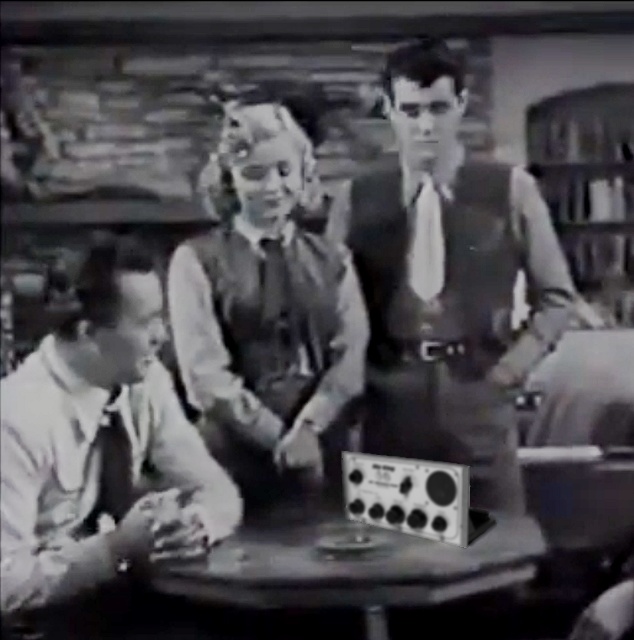Can you imagine how
Hollywood, with its sleaze and perversion, would portray
the Sky King show today? Perky little Penny all alone
out on the ranch with Uncle Sky. Look at Sky with his
firm jaw and his "no nonsense" gaze. He's wearing a
holster. He's got a gun to shoot bad people with! Quick,
change the channel. It's not politically correct, it's "offensive,"
and the gun is "triggering!"
I'm glad I grew up in the day when a kid could watch
good guys shoot bad guys on TV, and you'd feel really
good about them getting shot.
You have to wonder as you look at Penny's face, where are Sky
and Clipper's other hands? |
|
|
Back to the radio...
The short wave band (Band 4) didn't work very well.
|
The shortwave
band is at the top of the green coil, composed of six turns of wire.
The coil works well for broadcasts but I had to turn the volume all
the way up to hear any "hams." A coil of ten turns
of 24 gauge wire, space wound on a 1¼
inch coil form, covers the same band. When placed inside the
main coil, the difference in the radio's volume was
dramatic.
|
|
|
|
The little coil now lives
inside the big coil and is the new "Band 4." I hooked it up
backwards the first time so I used red and black wire to
prevent me from getting the wires mixed up.
|
|
|
|
After using the radio, it was found
that the control above, which coupled the RF amp to the tuning coil,
did very little. In series with the 365 pF variable capacitor was a
47pF fixed capacitor, which gave a total of 42pF with the plates
fully meshed. It was replaced with a 33pF fixed capacitor, which
costs about 20 cents versus the variable cap which costs about 20
dollars! |
|
|
|
|
|
The control was replaced with a "fine" regen
control, which works very nicely, but I had to peel the paper
faceplate off the front and make another one with the new
designation. |
|
|
|
They say that one definition of stupidity is
doing the same thing twice and expecting different results. The
little LM386 amplifier module I made in the left-hand photo gave me
nothing but trouble. The "stupid" part was that I had used this in
the "Ferrite Ferret" and it gave me nothing but trouble. If you turned the
volume up too high it would break into an ear-splitting howl. I
thought I had "fixed" it, but it wasn't fixed.
I replaced it with a $1.98 module that came as a kit from China. It
works great, has plenty of volume, and lights up. |
|
|
|
|
Rear View. The "binding posts" for the antenna
and ground have been replaced with 1 inch Fahnestock clips. |
|
How well does it work? Here's an example above. It just
shows it working, I didn't put much effort into the video.
|
I give it a score of "pretty good." I think that putting the small
coil inside the larger coil was probably detrimental to its
performance, because it interferes with the large coil, but it's
just a theory.
The original idea to use the circuit Greg sent me to build a solid
state Peebles "Two Tuber" with onboard Peebles antenna tuner evolved
into this. Mike Peebles himself liked the circuit, and he created the schematic below for this webpage.
|
|
|
|
|
|
|
|
|
The audio section is a standard
LM386 kit, but the jacks and pins on the circuit board weren't
needed for the radio. The price range is all over the place,
depending on where you buy them. In 2015 they were $1. In 2022 they
were $1.98, but some people sell them for as much as $10, so be
careful where you order from. |
|
|
 |
Sky King, Penny, and Clipper admire the
radio while
listening to "Coast To Coast AM" with George Noory.
They are discussing time travel in this episode of the program.
That's amazing, as George would say.
Remember Garry, the guy who told
me to change the value of the source resistor? He built a similar
radio that only has one knob.
He used a stick to control the regeneration. I would like to
strangle him. Coincidentally, the month and day on the battery is my
birthday.
By the way, the Sky King airplane shown on the previous page, which
I used to designate the "model number" of the radio, crashed in
1962, killing its pilot. |
|
|